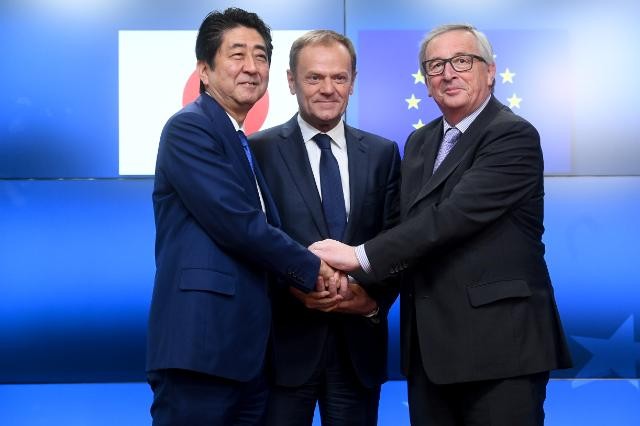(VOVWORLD) - The European Union and Japan have signed a free trade agreement after 5 years of negotiations. In the context of spreading trade protectionism, US President Donald Trump’s “America first” policy, and the escalating US-China trade war, the agreement conveys a protest against trade protectionism and major countries’ attempts to impose rules that favor themselves.
 The signatories of the treaty, Japanese Prime Minister Shinzo Abe and EU Presidents Jean-Claude Juncker and Donald Tusk (pictured in Brussels on March 21, 2017); European Commission The signatories of the treaty, Japanese Prime Minister Shinzo Abe and EU Presidents Jean-Claude Juncker and Donald Tusk (pictured in Brussels on March 21, 2017); European Commission |
The EU-Japan FTA will take effect in March, 2019 following legislative approval. The agreement creates an economic bloc which accounts for 30% of global GDP and has 600 million consumers in 29 countries. The EU will eliminate tariffs on 99% of imports from Japan and have roadmaps for tariff elimination on other Japanese imports like cars and TV.
FTAs without the US
The agreement was signed at a time when both Japan and the EU, long-time US allies, are suffering from US tariffs.
Since he took office, President Trump has pursued a policy of trade protectionism which has been condemned by other countries. Since Washington withdrew from several multilateral free trade agreements, no country has signed a bilateral trade deal with the US. Many countries have signed new bilateral or multilateral trade agreements like the Comprehensive and Progressive Trans Pacific Partnership Agreement which was created after the US withdrew from the Trans-Pacific Partnership Agreement.
Negotiations between the US and the EU launched by former US President Barack Obama have been suspended under the Trump administration. The EU is accelerating the signing of new free trade agreements with countries all over the world. Prior to the G20 summit, on July 6, the EU and Japan agreed to sign a free trade agreement and signed it 11 days later reducing business opportunities for US companies.
This year, the EU intends to sign tariff reduction and market opening agreements with Mexico and Chile and is negotiating a trade agreement with the Mercosur bloc which includes Argentina, Brazil, Paraguay, and Uruguay.
Canada and Mexico have signed a new agreement to replace the North America Free Trade Agreement (NAFTA) which is on the verge of collapse. The US’s withdrawal from the TPP and its tough stance on NAFTA negotiations have forced regional countries reconsider their dependence on the US market.
Upholding free trade
The EU-Japan FTA puts trade liberalization over trade protectionism. EU leaders have frequently visited the Middle East, Japan and China seeking cooperation opportunities. Head of the External Relations Commission of the German Parliament Nobert Roettgen once told President Trump that the concepts about friends, allies, partners, rivals and enemies are not always clear. It’s no surprise that the EU is now partnering with other countries.